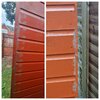- Joined
- 23 Sep 2023
- Messages
- 20
- Reaction score
- 4
- Country

I'm noticed the inside of my T+G shed walls are soaking in water big. At first I thought I'd put a few coats of shed paint to try and seal it up and see how if that resolves it. Unfortunately no luck. Just rained and the inside of the wall is getting wetter and more rotten by the day. Any suggestions?


